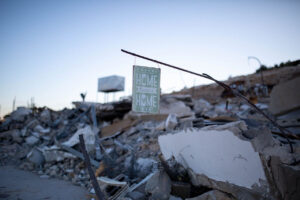I saw the first bulldozers arrive in my village 17 years ago. Now, after the most brutal weeks in our history, my son will carry similarly painful memories.

The rubble of a home in Umm al-Khair after it was demolished by the Israeli Civil Administration, occupied West Bank, July 7, 2024. (
The demolition forces enter the village. All the children run to their mothers, who scramble to salvage whatever they can from their homes before it’s too late. Everyone watches on anxiously to see who will be made homeless today. The bulldozers gather in the center of the village and then stop. Soldiers disembark. The villagers look each other in the eye, searching for words of comfort, but there are none. Our children ask us why this is happening, but we have no answers.
This was the scene on June 26 in my village of Umm al-Khair in the occupied West Bank, when Israeli forces demolished 11 homes, leaving families without shelter in the heat of summer. The demolitions were just the beginning of what became one of the most violent weeks in the history of our small agricultural community: we have since faced a sharp escalation in settler violence, with subsequent attacks seeing settlers shoot live ammunition in the village and destroy our water system during a severe heat wave.
On the morning of the demolitions, we got word that officials from the Israeli Civil Administration — which administers the lives of Palestinians under occupation — were gathered on the highway near our village together with Border Police officers and demolition equipment. We have become accustomed to experiencing major demolition operations here in the South Hebron Hills, under the pretext that the structures were built without permits. Yet we have no other choice: Israel routinely denies permits to Palestinians in Area C of the West Bank as a method to expel us from our lands.
Since October 7, the situation in Umm Al-Khair has been even more difficult than usual. And that morning, we quickly realized that we were about to witness another major demolition operation.
My cousin, Eid al-Hathaleen, an artist and community leader, was one of the villagers whose world was turned upside down. “As activists who regularly document demolitions, we immediately started monitoring what was happening,” he said. “After a while, a military convoy accompanied by three bulldozers moved toward our village, closed off all the entrances, and barred the media and activists from entering.”

The ruins of a large tent in Umm al-Khair after it was destroyed by Israeli bulldozers, occupied West Bank, June 27, 2024. (Sofia Fani Gutman)
Upon entering the village, the demolition forces went straight to one of the oldest tents in Umm al-Khair: the tent of the martyr Suleiman al-Hathaleen, a monumental figure who led the community for years and was crushed to death two years ago by an Israeli police truck that raided the village. The soldiers formed a line to prevent residents from reaching the tent before bulldozing it to the ground.
In our state of shock, we thought maybe that would be the only tent demolished that day. Instead, the occupation forces continued to the main electricity room in our village, to Eid’s home, and then to one of the largest families in Umm al-Khair to destroy all of their homes and everything they owned.
In total, 10 houses were demolished that morning, along with the village council tent and the solar electricity room. Thirty-eight residents are now homeless — including my sister, whose house was destroyed along with all her possessions. What was particularly shocking was that these were among the oldest homes in the village, with some having received demolition orders all the way back in 2008. Now we are worried about every single house here in Umm al-Khair.
During a demolition, there is the immediate pain and horror of losing your home. But perhaps the hardest moment is the first night without it. In the hours after the demolition, you will be surrounded by your friends from the community and those who have come from elsewhere to offer solidarity. But at the end of that evening, all of them will go back to their homes — while you and your family are left to sleep outside among the rubble of your memories.
“I never imagined sleeping in the open that night,” Eid said. “I cannot describe that situation — how much I wanted to express what was inside me, and what my family, who are now homeless, was facing. How can I reduce their fear and anxiety, their feeling of having no safe place?”
For my sister, it took a few days to begin to process the tragedy. “During the nights, we usually make dinner for everyone and sit together,” she told me. “Then my children go to hang out with their friends in the community, the young ones go to sleep, and we plan for the following morning. But in one moment, we found ourselves in an unsteady tent which cannot protect us from anything. So in these moments, we understood what had actually happened to us.”
More …


